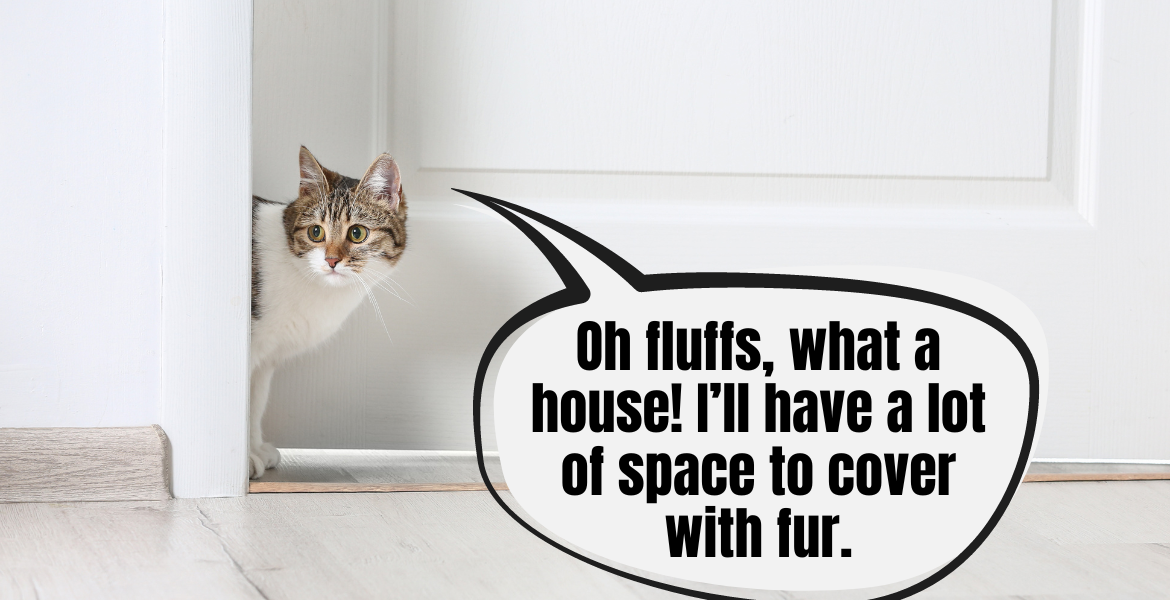Our myKotty team is gearing up for quite a challenge—our team cat Tosia is changing her meowdress. Amidst packing, piles of boxes, work, and the desire to minimize cat stress, it’s no surprise, fabCats, that this topic occupies our thoughts from morning till night. After all, home is not just four walls. It’s a feline territory, where furballs build their sense of security. But how do you move them to a new place without negatively affecting their health and psyche? And how do you acclimate a cat to a new environment so they quickly feel at home? Today, we’ll seek answers to these questions together. Stay with us, fabCats.
Does a cat get attached to their home?
A cat’s own territory is one of their most important resources. The ability to feel “at home,” marking all the nooks and crannies (by rubbing, leaving fur, scratching), moving freely, napping, eating, and playing—these matters are of great significance to cats. This is how nature shaped them; these values were inherited from their feline ancestors. So, when a cat finds themself in a completely new place, full of unfamiliar smells and corners, it’s no wonder they feel uneasy. It’s a bit like if we, humans, were suddenly evicted from our apartment and moved to a new city and an empty house, with no possibility of returning to the old place. A bit of a bummer, right?
So, let’s return to the question: “Does a cat get attached to their home?” The simple answer is: YES! Of course, they do. However, this does not mean a cat cannot move or acclimatize to a new place. Some cats will find it easier, and others may require medical or behavioral support, but moving with a cat is entirely possible in the overall balance. You just need to do it thoughtfully and give your kitty time to build a new empire.
Moving with a cat – what you need to remember
There are a few key aspects that can make the move more or less stressful for your cat:
- The confusion associated with packing, i.e., removing and rearranging things in the cat’s current territory.
- Encounters with strangers—the moving crew, new tenants coming to pick up the keys, friends helping you pack, etc.
- Traveling with the cat to the new place, sometimes several hundred kilometers away. If your cat doesn’t like traveling, even on short trips, this stage alone can be a huge challenge.
- Staying in a completely new place, full of new smells and furnishings (or completely empty, waiting to be furnished). Cats are curious, but in such situations, they often prefer to hide in a safe corner and wait out the chaos.
- The clamor during unpacking, assembling furniture, renovating, etc. Your cat may not want to watch this.
We can approach these problems separately, but one key element that will definitely improve your chances of success regardless of the above is… proper planning! Cats love routine, and although your furball won’t understand what you have planned in your calendar, the very fact that organization gives you peace and streamlines the moving process will make the cat feel better about it too. Remember, cats recognize your emotions. When you’re stressed, your kitty is too.
Developing an action plan. Mission: moving
There isn’t a single proven recipe that works for every move. You might be moving from an apartment to a larger house a few blocks away or a completely different city, on several trips by car or all at once, packing everything into a van. Your new place may already be furnished and previously inhabited or brand new, empty, where you can put your belongings already imbued with familiar smells. These factors will directly affect how you organize your life during the move. However, we have some tips for you on how to build your own, effective action plan.
Firstly, get organized. Think about how you will pack, and transport things to the new home, on which days you have time to handle the topic, and whether you can arrange a few days off during the move. Minimizing chaos also minimizes cat stress.
Secondly, get your current place ready. When you start packing, leave the cat’s key items out as long as possible. This means scratchers, favorite bedding, wall shelves, litterbox, and bowls. Let the cat watch all the commotion from places where they feel good and remove them only when you’re ready to load the cat into the carrier and car.
Thirdly, ensure safety. When you’re in the midst of the chaos of packing and moving boxes, accidents can happen at the least expected moment. And you don’t want to accidentally trip over the cat, crush it with a box, or unwittingly let it out the front door. When it’s time for the most hectic and intense phase of the move, separate the cat in one room—this could be the bedroom, wardrobe, or even the bathroom if you’re not going to use it anymore. Of course, this room should contain all the important resources for the cat—bowls, a litter box, their favorite furniture (e.g., a scratcher), and a hiding place. Take the cat and its items out of the apartment last when you’re ready to leave the place for good.
If, for some reason, it’s more convenient and safer for you to move the cat earlier, e.g., to the care of a family member, go ahead. Just remember that such a change of environment can also be a huge stressor for the cat. It’s best to leave such temporary care to people the cat knows well and in a place where it has been before.
Welcome to your new home, kitty!
We’re here! But what now? What should you do to make the first days after the move as bearable as possible for the cat?
Offer your company. If you can, move on a Friday and have a free weekend or take a few days off—it’s definitely worth it. Your presence at home, even if you’re busy unpacking and cleaning, will comfort the cat and make accepting the new place easier. After all, it’s true that cats get attached to their territory, but it’s even more true that they get attached to their hooman.
Give the cat space. We mentioned earlier how important it is to create a base room for the cat where they can feel at home. And we want to emphasize it again. By providing the cat access to all known resources and smells in a small area, you give them a retreat they can use if they feel the need. Allow it. Don’t force the cat to leave the hiding place before they’re ready. This may take a few hours, days, or weeks, but gradually building confidence is much better than throwing the cat into the deep end, so to speak.
Observe the cat and their behavior. In the first few days after the move, your cat may behave oddly—this is quite normal. However, it’s important for you, as the cat Guardian, to keep an eye on things and observe your cat’s behaviors. Are there signs of stress even when everything around has calmed down? Has your cat started to meow more, complain, lose appetite, playfulness, and trust in you? Any deviation from the norm, if it doesn’t subside over time, can be a warning signal. In such a case, seeking help from a veterinarian and behaviorist is advisable.
Now it’s time for your fabCat moving stories. Have you had the opportunity to change your meowdress with cats? How did it go? Or maybe you have some last-minute tips for us? Let us know in the comments and keep your fingers crossed for our Tosia! 😊




